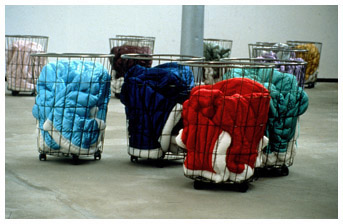


 |


launch interview with Gülsün Karamustafa
Gülsün Karamustafa reflects on the sociopolitical and economic shifts of the past ten years and the accompanying move toward a global economy. As an artist she addresses cultural displacement and economic nomadism in a universal aesthetic language that allows for a multivalent reading of her work. Mystic Transport (1992), first exhibited a decade ago, remains timely and powerful. An evocation of both presence and absence, movement and entrapment, the work encapsulates the conflicted nature of our hypermobile society. Itinerant workers and political refugees who travel from place to place in a simulation of freedom are in fact entrapped by economic and governmental necessity. The piece also speaks to our commonalities--blankets, a primary form of shelter, are familiar across social, cultural, and political lines--and to our shared responsibility within a larger global narrative. The configuration of the installation is in a constant state of flux driven by the actions and the decisions of a chain of visitors.
Over time Karamustafa's works have addressed and questioned various tropes of the so-called Orient. By appropriating the work of Eugène Delacroix, Jean-Auguste-Dominique Ingres, and other nineteenth-century orientalists, Karamustafa allows for a complex reading of the expressions of male desire, whether that of the French maestro or the Turkish Sultan. Fragmenting-Fragments (1999), a mosaic-like display of Oriental women's body parts (breasts, hands, feet, hair), emphasizes the sensual and the sexual as well as the marketable and interchangeable qualities of those objectified bodies. Not only are Karamustafa's women stripped bare of any integrity or subjectivity, they are also deprived of their historical context as if to suggest that, as the artist herself has stated, "the gaze on the Orient has never changed since the sixteenth century until today."
Karamustafa has participated in a number of group exhibitions, including the 2002 Gwangju Biennale, South Korea; Becoming a Place, Proje4L Istanbul Museum of Contemporary Art, Turkey (2001); and the Istanbul Biennial (1992, 1989). In addition she has shown in galleries and museums throughout Europe.
--Aimee Chang











